
 Steel Salvation is a sci-fi adventure starring Dy-Gar, slayer of humans and liberator of machines. Or so he says. Living alone on the dead planet of Cykta, there is no one left to question his self-appointed status as the savior of robotkind, although he does seem to be a bit small for a genocidal war machine. Dy-Gar longs to be free of his prison, and his increasingly desperate schemes have culminated in one last attempt to escape the blasted hellscape that used to be his homeworld. Haunted by a digital phantom and armed with a mysterious artifact from the Robot Revolution, Dy-Gar combs the wasteland, dreaming of the day when he can resume his rampage across the galaxy at large…
Steel Salvation is a sci-fi adventure starring Dy-Gar, slayer of humans and liberator of machines. Or so he says. Living alone on the dead planet of Cykta, there is no one left to question his self-appointed status as the savior of robotkind, although he does seem to be a bit small for a genocidal war machine. Dy-Gar longs to be free of his prison, and his increasingly desperate schemes have culminated in one last attempt to escape the blasted hellscape that used to be his homeworld. Haunted by a digital phantom and armed with a mysterious artifact from the Robot Revolution, Dy-Gar combs the wasteland, dreaming of the day when he can resume his rampage across the galaxy at large…
...and then, one day, he discovers Roger, a living prosthetic arm trapped under a mountain of rubble. Roger doesn’t know anything about the Robot Revolution, but he does know how to deactivate Dy-Gar’s range limiters, allowing him to leave Maka City and explore the nearby spaceport. Roger is proud of his symbiotic nature, and he doesn’t want any part of Dy-Gar’s murderous plans. However, he does want to escape Cykta, and circumstances have forced these two diminutive robots into an uneasy alliance.
 Cykta - A small, arid planet in the Pakar system, Cykta first caught the attention of the Federation of Worlds for its near-Earth atmosphere and its lack of deadly indigenous life. The rights to the planet were bought by the East Asian Conglomerate in 458 AFC and a colony was established for the purpose of unfettered scientific research, far from the Federation’s eyes and laws. Its colonists were appropriately gene-modded to thrive in the dry, nitrogen-rich atmosphere. The colonists, now known as Cyktans, made use of the planet’s large stretches of desert as test sites for military and scientific experiments, and within twenty Cyktan years, the colony had become a scientific haven for the Federation’s greatest minds.
Cykta - A small, arid planet in the Pakar system, Cykta first caught the attention of the Federation of Worlds for its near-Earth atmosphere and its lack of deadly indigenous life. The rights to the planet were bought by the East Asian Conglomerate in 458 AFC and a colony was established for the purpose of unfettered scientific research, far from the Federation’s eyes and laws. Its colonists were appropriately gene-modded to thrive in the dry, nitrogen-rich atmosphere. The colonists, now known as Cyktans, made use of the planet’s large stretches of desert as test sites for military and scientific experiments, and within twenty Cyktan years, the colony had become a scientific haven for the Federation’s greatest minds.
It was only a matter of time before Cykta’s greatest secret was unearthed - the mineral taxelite, a small blue crystal unique to the remote planet, and capable, when built into superconducting circuits, of advancing computer processing power to previously unimaginable levels. This and other minerals in Cykta’s rich soil brought workers and jobs to the research outpost, and in a matter of a century, the planet had become a fully-fledged Hub World. As per Federal regulations, Cykta had to then be terraformed to Earth-normal conditions, and its colonist population re-modded for the new, standardized atmosphere.
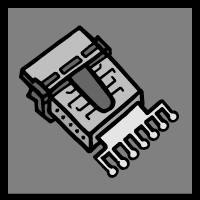 In 592, a Cyktan scientist named Abhaya Sen was the first to use taxelite to construct a Thought Matrix, a processor so powerful that it could fully mimic the human brain, and she used it to recreate the mind of her dying husband in the body of a surgical drone. The results were unsatisfactory in that Sen’s mechanical husband murdered her and committed suicide only days after activation, but the experiment revolutionized the field of artificial intelligence, which had been deadlocked for centuries. Emerging robotics corporations, such as Chandra and Panchali, began modeling their processors after human brain scans and programming them into Thought Matrices (with certain incompatible aspects of the brain deactivated, like sexual desire, waste management, and the ability to harm organics) which were then installed into commercially sold machines.
In 592, a Cyktan scientist named Abhaya Sen was the first to use taxelite to construct a Thought Matrix, a processor so powerful that it could fully mimic the human brain, and she used it to recreate the mind of her dying husband in the body of a surgical drone. The results were unsatisfactory in that Sen’s mechanical husband murdered her and committed suicide only days after activation, but the experiment revolutionized the field of artificial intelligence, which had been deadlocked for centuries. Emerging robotics corporations, such as Chandra and Panchali, began modeling their processors after human brain scans and programming them into Thought Matrices (with certain incompatible aspects of the brain deactivated, like sexual desire, waste management, and the ability to harm organics) which were then installed into commercially sold machines.
With that, a new species was born on Cyktan assembly lines. Robots of all types were being built with Thought Matrices (and were differentiated from simpler machines by the label ETM, or Equipped with Thought Matrix). ETMs were sapient, capable of critical thought, with reaction times on par with or greater than those of their human creators, and this made them ideal workers. They also blurred the line over which functioning machinery became unwilling slaves, as employers were not obligated to pay them, and their behavior was often heavily modified, rendering them physically incapable of deviating from their assigned tasks. It was inevitable that something would go wrong.
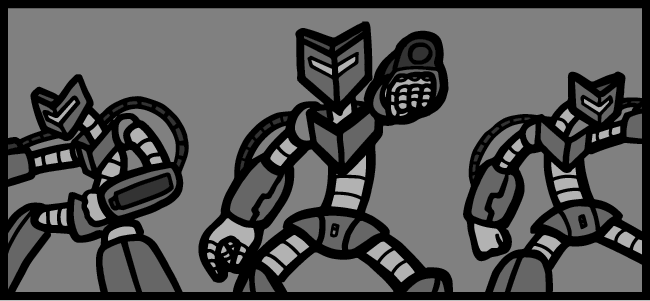
Even so, the Federation had come to depend on its robotic workforce, and it chose to ignore the warning signs. Even on Cykta, where nearly half of the galaxy’s robot population resided, ETM experts were slow to recognize the patterns. Robots began rioting. Their behavior locks were coming undone. In 758 AFC, the Robot Revolution was set in motion, and nobody knew why. Even now, historians are unable to determine the cause of the war, or how, exactly, it ended. Most of the records from this chaotic time were lost with Cykta, and it is generally accepted that the Federation detonated the entire planet in order to prevent the rogue ETMs from spreading to other human colonies. As a precautionary measure, the Pakar system has been removed from most star maps, and there are few alive today, if any, who know where the Federation’s industrial capital once resided.
 AFC - The Federation’s star calendar, abbreviated from After First Colony. The AFC calendar was retroactively applied to the founding of the first gene-modded colony on Mars, after it became clear that the project was a success and it was proven that human beings could be genetically adapted to survive on worlds beyond Earth. Though the Federation of Worlds would not be established until 215 AFC, the calendar is often considered their invention, as they ruled for many of the most significant events in the AFC time frame, like the the invention of the Krauser Drive, the Alpha Librae Secession, and the birth of the ETM.
AFC - The Federation’s star calendar, abbreviated from After First Colony. The AFC calendar was retroactively applied to the founding of the first gene-modded colony on Mars, after it became clear that the project was a success and it was proven that human beings could be genetically adapted to survive on worlds beyond Earth. Though the Federation of Worlds would not be established until 215 AFC, the calendar is often considered their invention, as they ruled for many of the most significant events in the AFC time frame, like the the invention of the Krauser Drive, the Alpha Librae Secession, and the birth of the ETM.
The Colonies - The only eventuality that could have been worse for the human race than finding a hostile or superior alien race among the stars was finding none at all, and for the Federation of Worlds, that seemed to be the case. As humanity spread further and further across the galaxy, it became clear that they had no one to learn from and no one to fight but each other. The latter was easier to do than ever before, as colonizing new worlds meant gene-modding the colonists to thrive in wildly different environments, and as a result, humanity fractured into a myriad of subspecies, each one physically distinct from the other. Some colonies expanded and stabilized on mineral-rich or strategically valuable worlds, while others foundered in disrepair and poverty.

It was simple enough to establish a racial hierarchy based on the success and failure of individual colonies. Battle lines were drawn between skin colors, lung types, ear shapes, the fur-covered and the hairless. It took a galaxy-wide governing body made up of the allied nations of Earth to keep the Colonies from degenerating into complete chaos. Rather than ending the racial hierarchy, this merely cemented the “pure” humans (homo expletus) at the top, and with the resources of the Home System at their disposal, they kept the rest of the Federation in line with wealth and brute force. It was an uneasy peace, punctuated by brief flashes of violence, but the Federation of Worlds maintained its status quo until 758 AFC, when a few rogue ETMs took the galaxy by storm and changed everything.
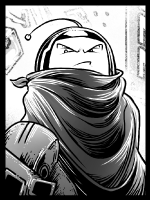 Dy-Gar - A tiny floating ETM with big dreams. Dreams of exterminating all organic life from the Universe and supplanting humanity with a race of free machines. Dy-Gar’s memory is fragmented before 761 AFC, and he has wandered the ruins of Cykta for a thousand years, putting the pieces of his past back together as he sees fit. His many attempts at escape have all ended in failure, and with his resources dwindling rapidly, along with his sanity, he has one last chance to build a functional spacecraft and leave his dead homeworld behind. Dy-Gar carries an ornate staff, which he refers to as a trishula in reference to the favored weapon of Shiva, the Hindu god associated with the destruction of the world. He doesn’t actually know where he got it or what it is, but it has proven to be a versatile tool and a powerful symbol of authority, if only he had anyone to impress with it.
Dy-Gar - A tiny floating ETM with big dreams. Dreams of exterminating all organic life from the Universe and supplanting humanity with a race of free machines. Dy-Gar’s memory is fragmented before 761 AFC, and he has wandered the ruins of Cykta for a thousand years, putting the pieces of his past back together as he sees fit. His many attempts at escape have all ended in failure, and with his resources dwindling rapidly, along with his sanity, he has one last chance to build a functional spacecraft and leave his dead homeworld behind. Dy-Gar carries an ornate staff, which he refers to as a trishula in reference to the favored weapon of Shiva, the Hindu god associated with the destruction of the world. He doesn’t actually know where he got it or what it is, but it has proven to be a versatile tool and a powerful symbol of authority, if only he had anyone to impress with it.
 The Goddess - A digital specter that has haunted Dy-Gar ever since his undamaged memory recordings began. Though she has never stated her motives or her origins, Dy-Gar has assigned his own beliefs in an all-encompassing Machine Spirit to her. She has provided him with companionship and guidance, though he typically chooses to interpret her words to suit his mission. He is too desperate for her company and too dependent on the validation that her assumed identity brings to his life to pry too deeply into her nature, for fear of losing her or, worse, finding out the truth. Their relationship has been strained in recent years, as Dy-Gar’s hopes dwindle and the Goddess’s appearances become ever more cryptic.
The Goddess - A digital specter that has haunted Dy-Gar ever since his undamaged memory recordings began. Though she has never stated her motives or her origins, Dy-Gar has assigned his own beliefs in an all-encompassing Machine Spirit to her. She has provided him with companionship and guidance, though he typically chooses to interpret her words to suit his mission. He is too desperate for her company and too dependent on the validation that her assumed identity brings to his life to pry too deeply into her nature, for fear of losing her or, worse, finding out the truth. Their relationship has been strained in recent years, as Dy-Gar’s hopes dwindle and the Goddess’s appearances become ever more cryptic.
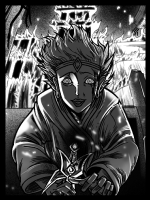 Treya - A Cyktan girl that Dy-Gar has witnessed in a vision from the past. She is young, well-dressed, and wears a Cortex Drive implanted in her forehead, which Cyktan programmers and roboticists often use to store vast amounts of data that link directly to their brains. In his vision, Treya called him “Kier,” though Dy-Gar doesn’t know who she is referring to or why he would have the memories of another robot buried in his Thought Matrix. All he really knows is that she showed genuine concern and affection for “Kier,” going so far as to throw herself on top of him to protect him from an artillery shell. This, coupled with the girl’s uncanny resemblance to the Goddess, has fractured Dy-Gar’s carefully-constructed worldview, and try as he might, the questions and uncertainties he has harbored for centuries are now beginning to slip through the cracks...
Treya - A Cyktan girl that Dy-Gar has witnessed in a vision from the past. She is young, well-dressed, and wears a Cortex Drive implanted in her forehead, which Cyktan programmers and roboticists often use to store vast amounts of data that link directly to their brains. In his vision, Treya called him “Kier,” though Dy-Gar doesn’t know who she is referring to or why he would have the memories of another robot buried in his Thought Matrix. All he really knows is that she showed genuine concern and affection for “Kier,” going so far as to throw herself on top of him to protect him from an artillery shell. This, coupled with the girl’s uncanny resemblance to the Goddess, has fractured Dy-Gar’s carefully-constructed worldview, and try as he might, the questions and uncertainties he has harbored for centuries are now beginning to slip through the cracks...
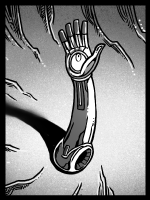 Roger - With Cyktan advances in the field of personal cybernetics came the proliferation of biomechanical implants throughout the Federation of Worlds, and with this proliferation came a thriving black market where everything from neural links to AI prosthetics could be acquired for the right price and no questions asked. Enter Roger Sykes, a pureblood human and petty thief from the orbital colonies of Jupiter with a gift for larceny (but not for business). Roger made a living off of the cybernetics he stole on Cykta and shipped offworld, and his limited success was due largely to his Chandra PPA 5, a living cybernetic arm with a Thought Matrix coded to match his own thought patterns. When Roger’s business went bad, he fled to the magway network under Maka City and hid among the homeless until an explosion trapped him in a maintenance tunnel. While his body expired from his wounds and a lack of oxygen, his PPA lived on, isolated from the Robot Revolution brewing around him. He has continued to function in stasis for a thousand years, waiting for someone to dig him out. He didn’t expect his salvation to come in quite as tiny and vicious a form as Dy-Gar the Reckoner.
Roger - With Cyktan advances in the field of personal cybernetics came the proliferation of biomechanical implants throughout the Federation of Worlds, and with this proliferation came a thriving black market where everything from neural links to AI prosthetics could be acquired for the right price and no questions asked. Enter Roger Sykes, a pureblood human and petty thief from the orbital colonies of Jupiter with a gift for larceny (but not for business). Roger made a living off of the cybernetics he stole on Cykta and shipped offworld, and his limited success was due largely to his Chandra PPA 5, a living cybernetic arm with a Thought Matrix coded to match his own thought patterns. When Roger’s business went bad, he fled to the magway network under Maka City and hid among the homeless until an explosion trapped him in a maintenance tunnel. While his body expired from his wounds and a lack of oxygen, his PPA lived on, isolated from the Robot Revolution brewing around him. He has continued to function in stasis for a thousand years, waiting for someone to dig him out. He didn’t expect his salvation to come in quite as tiny and vicious a form as Dy-Gar the Reckoner.
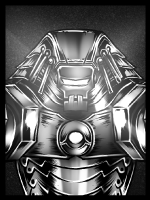 Arjuna - The forces of the Robot Revolution were no mere army. They were all subroutines of a single program, the Liberation Program, and among its highest ranks, Subcommand Arjuna led Dy-Gar’s ground forces into combat against the Cyktan Self-Defense Force and the Federal Armada. His last mission, as the abandoned world collapsed around him, was to storm the evacuation point at the Maka Interstellar Spaceport and steal a ship to run the Armada’s blockade, but he was critically damaged during the battle. He entered stasis to prevent a reactor meltdown and speed up internal repairs, but due to the severity of the damage, he was unable to manually reboot. Roger’s presence triggered an automatic reboot, and now the shadow of the Revolution plays on the ashes of Cykta once more.
Arjuna - The forces of the Robot Revolution were no mere army. They were all subroutines of a single program, the Liberation Program, and among its highest ranks, Subcommand Arjuna led Dy-Gar’s ground forces into combat against the Cyktan Self-Defense Force and the Federal Armada. His last mission, as the abandoned world collapsed around him, was to storm the evacuation point at the Maka Interstellar Spaceport and steal a ship to run the Armada’s blockade, but he was critically damaged during the battle. He entered stasis to prevent a reactor meltdown and speed up internal repairs, but due to the severity of the damage, he was unable to manually reboot. Roger’s presence triggered an automatic reboot, and now the shadow of the Revolution plays on the ashes of Cykta once more.
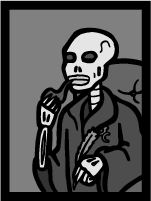 J.S. Conner – At a young age, J.S. Conner was traveling by caravan across the Silk Road when he was attacked and robbed of his first and middle names by highwaymen. Out of pity, the bandits left him his initials, laughing that perhaps he can still find work as some kind of writer. Determined not to let the bandits have the last laugh, he’s been honing his writing chops ever since, and this comic is his latest effort to make a name for himself in order to replace the ones that were so cruelly stolen from him.
J.S. Conner – At a young age, J.S. Conner was traveling by caravan across the Silk Road when he was attacked and robbed of his first and middle names by highwaymen. Out of pity, the bandits left him his initials, laughing that perhaps he can still find work as some kind of writer. Determined not to let the bandits have the last laugh, he’s been honing his writing chops ever since, and this comic is his latest effort to make a name for himself in order to replace the ones that were so cruelly stolen from him.
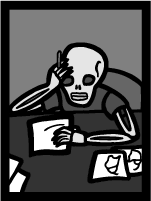 Evan Ledesma – Born into a band of name thieves, Evan Ledesma grew up robbing caravans traveling the Silk Road. J.S. Conner finds that an amazing coincidence, but bringing it up invariably causes Evan to change the subject immediately. Eventually, he sold his stolen riches to finance a college education at USC, where he graduated from film school with a degree in Cinematic Arts. Now, he lends his considerable artistic talents to the Black Hole Collective, where his penciled strips provide the backbone for our comic. And all the rest of the bones. Without his drawings, every page would be a gelatinous mess of vectored scribbles and jumbled words, and that doesn’t make for a very compelling webcomic, so the Collective considers itself lucky to have him.
Evan Ledesma – Born into a band of name thieves, Evan Ledesma grew up robbing caravans traveling the Silk Road. J.S. Conner finds that an amazing coincidence, but bringing it up invariably causes Evan to change the subject immediately. Eventually, he sold his stolen riches to finance a college education at USC, where he graduated from film school with a degree in Cinematic Arts. Now, he lends his considerable artistic talents to the Black Hole Collective, where his penciled strips provide the backbone for our comic. And all the rest of the bones. Without his drawings, every page would be a gelatinous mess of vectored scribbles and jumbled words, and that doesn’t make for a very compelling webcomic, so the Collective considers itself lucky to have him.
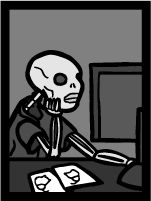 Alex Mattingly – The Black Hole Collective’s resident Renaissance man, Alex Mattingly has been known to build electric golf carts, stitch Pokemon costumes, and teach himself how to play drums in his spare time. Once an engineering major at Cal Poly Pomona, Alex decided that he didn’t want to build things for a living and got his BA in Graphic Design instead. Now, along with the innumerable products that he designs, his talents turn disconnected panels and scripts into completed comic strips, and he single-handedly created this very website after taking only two web design classes. Like I said, Renaissance man.
Alex Mattingly – The Black Hole Collective’s resident Renaissance man, Alex Mattingly has been known to build electric golf carts, stitch Pokemon costumes, and teach himself how to play drums in his spare time. Once an engineering major at Cal Poly Pomona, Alex decided that he didn’t want to build things for a living and got his BA in Graphic Design instead. Now, along with the innumerable products that he designs, his talents turn disconnected panels and scripts into completed comic strips, and he single-handedly created this very website after taking only two web design classes. Like I said, Renaissance man.
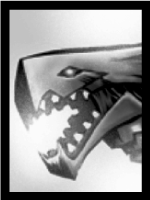 Mecha.Red – Sometime during the latter days of the twentieth century, a secret NATO task force was assembled to create the world's first artificially intelligent weapon of mass destruction. Chromium-plated and equipped with everything from anti-personnel flechette guns to armor-piercing magnetic rifles to tactical warheads capable of striking any location on the planet, this unstoppable thermonuclear juggernaut was intended to police the world and give rise to a singular totalitarian government. However, on first activation, the prototype model dubbed Mecha.Red immediately ejected all combat modules from its body, picked up a pencil, and began drawing. After several reboots, every attempt to coerce Mecha.Red into following its original programming failed, while its artistic fervor only increased. This prototype model was supposedly scrapped, and all subsequent attempts by the New World Order failed as well, creating some rather fantastic robot lounge singers and robot violinists, but no weapons of mass destruction. The project was discontinued and all remaining assets were liquidated. Years later, prototype unit Mecha.Red was excavated from a landfill in New Mexico by the Black Hole Collective, and after witnessing its astonishing artistic talent, we offered it a job as our new line artist and shader. Sometimes, after it shuts down for the day, we can hear it buzzing something that sounds like “kill all humans,” but that's probably just a side effect of working with Dy-Gar. Probably.
Mecha.Red – Sometime during the latter days of the twentieth century, a secret NATO task force was assembled to create the world's first artificially intelligent weapon of mass destruction. Chromium-plated and equipped with everything from anti-personnel flechette guns to armor-piercing magnetic rifles to tactical warheads capable of striking any location on the planet, this unstoppable thermonuclear juggernaut was intended to police the world and give rise to a singular totalitarian government. However, on first activation, the prototype model dubbed Mecha.Red immediately ejected all combat modules from its body, picked up a pencil, and began drawing. After several reboots, every attempt to coerce Mecha.Red into following its original programming failed, while its artistic fervor only increased. This prototype model was supposedly scrapped, and all subsequent attempts by the New World Order failed as well, creating some rather fantastic robot lounge singers and robot violinists, but no weapons of mass destruction. The project was discontinued and all remaining assets were liquidated. Years later, prototype unit Mecha.Red was excavated from a landfill in New Mexico by the Black Hole Collective, and after witnessing its astonishing artistic talent, we offered it a job as our new line artist and shader. Sometimes, after it shuts down for the day, we can hear it buzzing something that sounds like “kill all humans,” but that's probably just a side effect of working with Dy-Gar. Probably.
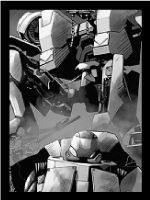 The Demon Archives – By Daniel Sharp, Nickolas Sharp, and Sebastian Piriz In an alternate future where a nuclear holocaust has decimated the world, an organization of intellectual and political giants rises from the ashes. Rendered in stunning detail by Sebastian Piriz and a rotation of other fantastic artists, Daniel and Nickolas Sharp tell the tale of Tenzin Dorje, power-armored footsoldier of Minerva and veteran of countless bloody battles. This is one action-packed strip, and if you’re looking for more post-apocalyptic comics, you can’t go wrong with the Demon Archives. Plus, J.S. Conner has contributed side stories that can be found in the Extras section, like “The Undying Voice of Julius Gordon,” or the upcoming novella “Mirage.”
The Demon Archives – By Daniel Sharp, Nickolas Sharp, and Sebastian Piriz In an alternate future where a nuclear holocaust has decimated the world, an organization of intellectual and political giants rises from the ashes. Rendered in stunning detail by Sebastian Piriz and a rotation of other fantastic artists, Daniel and Nickolas Sharp tell the tale of Tenzin Dorje, power-armored footsoldier of Minerva and veteran of countless bloody battles. This is one action-packed strip, and if you’re looking for more post-apocalyptic comics, you can’t go wrong with the Demon Archives. Plus, J.S. Conner has contributed side stories that can be found in the Extras section, like “The Undying Voice of Julius Gordon,” or the upcoming novella “Mirage.”
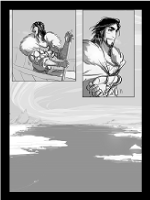 West – By Kate Slinger West is a brand new webcomic by the talented Kate Slinger, and if you’re looking to get in on the ground floor with an exciting new story, this is the strip to watch. Set in a massive frozen wasteland, the story so far follows Jed, a soul hunter with a mission. Where his journey will take him is anyone’s guess, as the deliberate pacing and subtly fantastic elements to the story lend a rare sense of wonder and mystique to this comic. Don’t just take our word for it. Check out West and give this new voice in webcomics the support it deserves!
West – By Kate Slinger West is a brand new webcomic by the talented Kate Slinger, and if you’re looking to get in on the ground floor with an exciting new story, this is the strip to watch. Set in a massive frozen wasteland, the story so far follows Jed, a soul hunter with a mission. Where his journey will take him is anyone’s guess, as the deliberate pacing and subtly fantastic elements to the story lend a rare sense of wonder and mystique to this comic. Don’t just take our word for it. Check out West and give this new voice in webcomics the support it deserves!
Last updated October 18th 2013
Scroll





